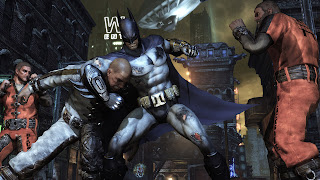Holy complex control schemes, Batman! The first time I was ever in a fight in Batman: Arkham City, I felt like I was struggling to manically press all the “counter” button even as the tutorial was telling me how to do it. Little lightning bolts appear above your enemies’ heads as the counter option appears…usually for a split second. I have no idea if that’s how it was in Arkham Asylum, the game’s predecessor; but it seems extremely time-sensitive; and in that way that I usually just have to press “punch” ([ ]) and “dodge”. (X)
Though I do try to counter when the opportunity arises, one miss can screw up the flow of combat, and then the screen gets all blurry as you get beat up, which is no fun. What is fun is how many moves you can do just by mashing button combinations. The fast-paced combat is actually what makes it kind of fun, so it’s a double-edged sword. Most of the combat seems to borrow from stealth games like Tenchu, which encourage silent takedowns. Those are always fun to watch. Knocking heads together, chokeholds, DDTs, etc. The game even slows down to show you the takedowns, or just to tell you that you beat up the last guy in a group.
But, it’s in using your gadgets that the controls get really complex. To use gadgets, you have to hit and hold L1. Sometimes, it’s not too hard, but I can hardly imagine a situation where a batarang would be more useful in a takedown than a few punches. No! Paradoxically, the gadgets that the game has you repeatedly use in combat, like the stun gun, have incredibly complicated buttons. Hold L1 to get it out, R1 to aim and square to fire. While in combat! So, I had some help with that one, but certainly those of us with less dexterity will struggle. You need the stun gun, because most thugs have guns, and guns take you down quick. If I were on a keyboard, maybe it wouldn’t have been a problem.
Overall, I think the game divides itself into two sections: Combat and detective work. I’m better at detective work. And actually, since it’s primarily a stealth game, your greatest advantage in combat (A la Tenchu: Stealth Assassins for PS1, but with Batman instead of ninjas!) is not being seen, and sneaking up for a silent takedown. Several missions require you to do this, especially when rescuing hostages. Oddly, I’m 90% sure the only way to regain health is by winning fights; which is okay, because fighting as Batman feels cool, but it means the only way to regain health is to put your health at risk: Batman logic!
The villains you’ll be fighting are essentially dark versions of the 90s animated series characters, with Mark Hamill back as the voice of Joker. But, this is no kids’ game. The puzzles are complicated, and often involve you backtracking several times to the same spot. The missions are never straightforward. Say you need to find Joker. What you actually NEED to do is FIND his radio signal, and then break your way into his hideout in a steel mill because front doors are almost always locked. Then, fight a boss. Then solve a puzzle. THEN, find Joker. Well, it isn’t easy being Batman.
The advantage to this though, is it adds to the logic puzzles, as well as keeps you in one area for a longer amount of time. Nobody wants the mystery to be over in 5 minutes. Also, it keeps you from going into areas you’re not beefed up enough to go into; many of which involve big enemies. But, if you do find yourself in such a situation, you can always, beat up random thugs until you level up, and regain health, and get stronger. You can even respond to other side-crimes happening in Arkham City. Because it’s Batman!
In sum, it’s a fun game, though the control scheme is a little complex on the PS3. I assume this could be easily remedied by playing it for the computer. You can remap the Playstation 3 buttons by types , but not individually. I wonder if you can do that on a computer! Nevertheless, with its engrossing super detective work, combat, and large environment Arkham City is a place where Batman’s super ninja and super detective skills mix quite well!
ACCESSIBILITY GRADE: B (Easy enough to master basics, but gadgets can be difficult.)
FORGIVENESS FACTOR: A (Checkpoints recap missions; infinite continues, side missions build up strength, detective work adds variety and fun challenge.)
CONTROLS: C (Many difficult combinations; time-sensitive moves; some button-mashing/fast tapping.)
FIGHTING!
GLIDING!
(Shhh...sneaking.)
DECODING!




.jpg)

.JPG)

